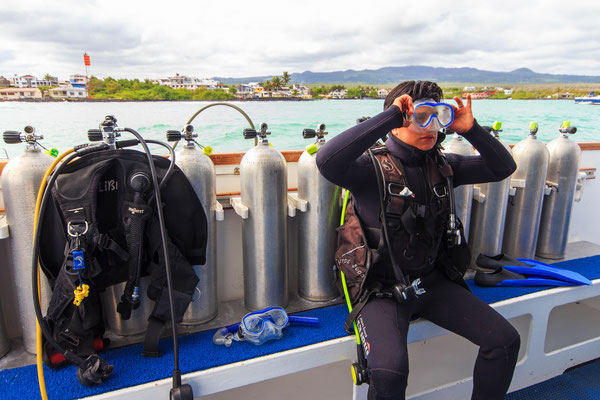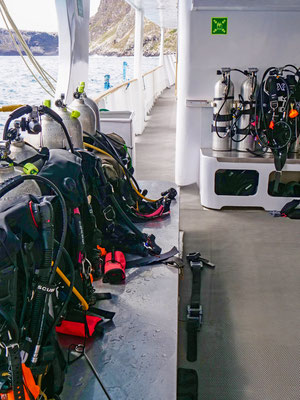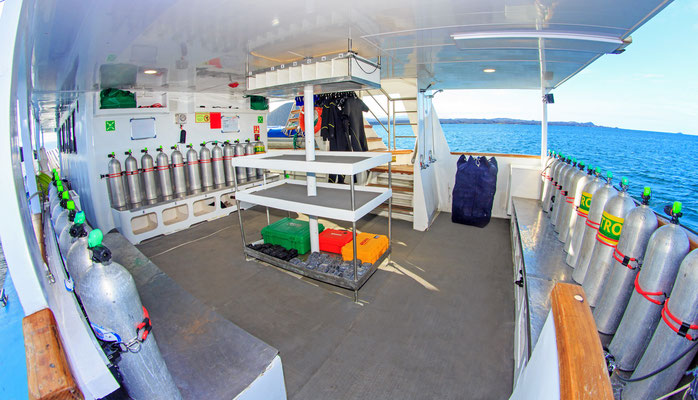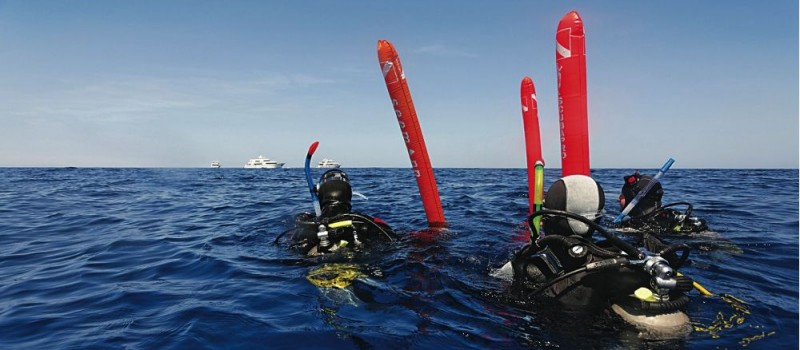Find out the Scuba gear and equipment that keeps you safe and comfortable while diving in the Galapagos Islands

Jenny Waack (founder of Galapagos Shark Diving®) and Jonathan Green (Tour Leader of Galapagos Shark Diving® and Director of Galapagos Whale Shark Project) discuss the best gear and equipment to keep you safe and comfortable while scuba diving in the Galapagos archipelago. The information in this post was extracted from a Travel EmOcean podcast episode #5 recorded on July 20, 2020. Click here to listen to the full episode.

What type and thickness wetsuit do you recommend using while diving in the Galapagos?
Jenny and Jonathan dive with a semi-dry seven-millimeter (quarter-inch in the U.S.) wetsuit. While diving the colder area down on the Western side of Isabella, they recommend you wear a shorty on top of the seven-millimeter wetsuit and a rash guard under the wetsuit. When diving the Northern areas (Wolf and Darwin), a seven mill is more than enough, and you can probably get away with a five mill with a rash guard or a skin underneath it. It’s better to be too warm than cold.

In addition to a wetsuit, what other gear do you recommend using while diving in the Galapagos?
Diving in a vest with a hood attached is recommended and versatile since you can decide underwater if you want to have the hood on or off. Jenny and Jonathan recommend a thin (three-four millimeter maximum) sleeveless vest. Dive gloves are also recommended since the two body parts where you lose the most heat are your hands and your head.

Would you recommend diving with a drysuit in the Galapagos?
If you are extremely susceptible to the cold, you could bring a drysuit. For most of the diving that we do, it's not necessary.
Are there disadvantages to using a drysuit?
Drysuits are a lot more difficult to get on and off. You might get more tired if you're doing multi-dive days (up to four dives a day on our trips). Additionally, your air consumption is going to be higher because you're using your suit as an inflation device so you'll probably have a shorter dive than others. If you're gonna bring a drysuit, we would recommend that it's a crushed neoprene as opposed to a trilaminate suit because they tend to be much less bulky.

What dive equipment & safety items does the vessel provide?
- Tanks
- Weights
- Weight belts
- Surface maker buoy (SMB) or safety sausage (Used to indicate your position when you surface)
- Nautilus (Can be used to transmit your position in times of emergency or urgency)
- DiveAlert (Type of horn/loud whistle that can be used to catch the attention of a boat driver or fellow divers)

What dive equipment would you recommend bringing on a liveaboard?
Galapagos Shark Diving strongly recommends bringing your own dive equipment because diving in Galapagos can be challenging and it is important that you are comfortable. Even if you are renting your equipment, we encourage you to bring your own mask and dive computer since this makes a huge difference in your comfort and safety.
Which items should I include in my dive bag?
- Certification card
- Diving log book
- Wetsuit
- BCD
- Regulators
- Octopus
- Mask
- Snorkel
- Fins
- Booties
- Dive computer
- Gloves
- Hood/hooded vest
- Rash guard
Additional suggested:
- Camera
- Dive knife
- Flashlight (if you intend to go night diving)
- Small portable strobe light (for emergencies)
- Small repair kit
- Safety sausage & DiveAlert (will be provided by the ship)
*For additional information please see our Tips for your Galapagos Dive Trip page (Click Here)
What if I do not have my own dive equipment or do not have the ability to travel with my equipment?
If you would like to rent the dive equipment in the Galapagos, we can organize this for you. Please indicate on your application form what equipment you will require. Please (Click Here) to see diving equipment rental pricing.

In conclusion, having the appropriate dive gear and equipment is very important to help you stay safe and comfortable while diving in the Galapagos. If you have any additional questions for us, please email us at info@galapagossharkdiving.com and we would be happy to provide additional guidance.











Write a comment